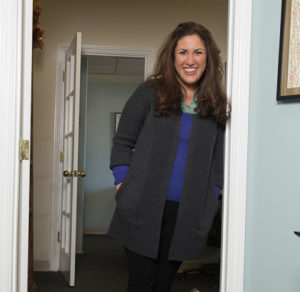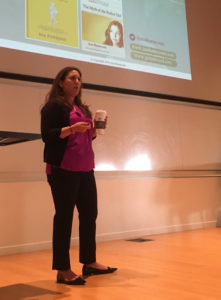 Ever since my new book SOCIAL MEDIA WELLNESS came out August 29, I have been on book tour visiting schools in cities around the country and talking to parents, students, and faculty members about understanding our current social media landscape, managing digital distractions, and promoting wellness in an always on-digital world. The tour has been energizing, in large part because social media is a topic that everyone wants to talk about, and nearly everyone has opinions. Parents and students really want strategies that work. They’re in luck, because I spent nearly four years writing and re-writing a book full of effective and practical approaches to encouraging better habits online and in-real-life (IRL).
Ever since my new book SOCIAL MEDIA WELLNESS came out August 29, I have been on book tour visiting schools in cities around the country and talking to parents, students, and faculty members about understanding our current social media landscape, managing digital distractions, and promoting wellness in an always on-digital world. The tour has been energizing, in large part because social media is a topic that everyone wants to talk about, and nearly everyone has opinions. Parents and students really want strategies that work. They’re in luck, because I spent nearly four years writing and re-writing a book full of effective and practical approaches to encouraging better habits online and in-real-life (IRL).
I talk a great deal about the spectrum of parenting around social media which ranges from the overly permissive “everything is allowed” all the way to what I’ve dubbed fear-based abstinence, where nothing seems to be allowed ever – except that kids readily admit to creating accounts their parents don’t know about, so that approach tends to be ineffective – not to mention potentially dangerous.
People often ask me what questions I hear the most from parents. Here are the top two – and my thoughts:
Q: At what age should my child get a mobile phone (or a smartphone)?
 This question comes up whenever I have an audience of elementary or middle school parents. In reality, the question of when a child should get a cell phone or smartphone are actually two different questions. In a world where there aren’t payphones on every corner and we are unfortunately experiencing a number of man-made and natural disasters, I do think safety and convenience warrants some kids to get a mobile phone earlier than in previous years. If a child lives in two-households, has late-night extracurricular activities or sports practices, it can make sense from a convenience standpoint to have a mobile phone.
This question comes up whenever I have an audience of elementary or middle school parents. In reality, the question of when a child should get a cell phone or smartphone are actually two different questions. In a world where there aren’t payphones on every corner and we are unfortunately experiencing a number of man-made and natural disasters, I do think safety and convenience warrants some kids to get a mobile phone earlier than in previous years. If a child lives in two-households, has late-night extracurricular activities or sports practices, it can make sense from a convenience standpoint to have a mobile phone.
However, getting a mobile phone doesn’t necessarily mean getting a smartphone, which typically has a built-in camera and video. Camera, video, and video live feed create a whole new ballgame, especially in a world where many middle school and high school students struggle with impulse control and admittedly take things to social media when they are angry or passionate about something.
This past summer, I asked a group of high school seniors in my office at what age they thought kids should get a smartphone, and they were resoundingly adamant that kids should wait until the 8th grade to get a smartphone. They had no idea their recommendations were in line with a campaign called Wait Until 8th, which was started by a group of parents who wanted to have parents and students sign a pledge waiting until 8th grade to get a smartphone.
The high school students I interviewed had really thoughtful reasons why they thought kids should wait until eighth grade to get a smartphone – the potential for distractions, the challenge it can be for middle school students to self-regulate, and the underlying social and emotional manipulations that can be overwhelming. I so think it all depends on the child (which is tough!), but I do agree that many children get smartphones before they are ready for full access. In my mind, finding ways to provide tiered access to phone use is generally the most effective, but what that means for one family – or even one child within the family – can be different than for another. Even when kids do get a smartphone, parents should have access to know what apps are being downloaded, and use that to start conversations and awareness around use.
 Finally, even when children do get a smartphone, they need guidance around creating structure and limits. It is easier to have conversations and create collaborative agreements (that can always be revisited and revised) before kids have a phone. Once the phone is in their hands, they naturally become a little more distracted – quite like adults!
Finally, even when children do get a smartphone, they need guidance around creating structure and limits. It is easier to have conversations and create collaborative agreements (that can always be revisited and revised) before kids have a phone. Once the phone is in their hands, they naturally become a little more distracted – quite like adults!
Q: How can I monitor/spy on/know what my child is doing online? Some version of this sometimes includes: shouldn’t my kid have privacy to make mistakes?
The whole monitoring/spying/privacy debate is often a funny one for me, because there are often multiple vantage points and cultural values coming into play. My parents are immigrants to the United States, and like many children of immigrant parents, I sometimes laugh at the American ideal of teenage privacy. Immigrant parents are usually like, “Privacy, what? Do I not pay for this phone? Do I not pay for the food and roof above your head? I get full access.” (If you need any further understanding of the immigrant parent mentality around issues like this one, I encourage you to watch Hasan Minhaj’s “Homecoming King” comedy special on Netflix).
All kidding aside, many school deans and principals will tell me that law enforcement officials will be in the school office meeting with parents and a student who has done something inappropriate (and potentially illegal) and the parents will say, “I didn’t know I should have been looking at my child’s phone.” To which the law enforcement officer is usually dumbfounded.
I encourage parents of middle schoolers to explain that they have full access to their child’s phone at any time, and to have a rule that phones are charged downstairs at night. For the parents of high school students, I encourage them to figure out what their access is based on their unique situation, but regardless, they should have all passwords in sealed envelope – at the very least – in case something ever goes awry.
In terms of monitoring, I encourage parents to be open and honest that they have full access to the phone if they are  concerned about anything, and if you are using a monitoring app, let your kids know. Apple’s Family Share Plan and Google Play Family have helpful features. Phones have parental controls – parents just have to use them.
concerned about anything, and if you are using a monitoring app, let your kids know. Apple’s Family Share Plan and Google Play Family have helpful features. Phones have parental controls – parents just have to use them.
Parents often ask me about the different monitoring apps available, and I offer suggestions with a caveat: like everything, it is all about attitude and approach. When one dad at a high school told me he saw something inappropriate on his daughter’s phone and now wanted to know the best app to monitor her, I asked him if he had talked to his daughter about what he had seen – he hadn’t.
Monitoring apps like OurPact and Bark work best when they are used in conjunction with frequent open-ended conversations around appropriate use. They are not a substitute for important (and sometimes uncomfortable) conversations.
Much of what I talk about in SOCIAL MEDIA WELLNESS is around how we are often having the wrong conversations with kids around social media. Instead of coming from a place of fear, anger and frustration, we need to have more compassion, empathy and understanding. Teens and tweens are trying to navigate a whole new world and language of socialization, and they need our help – but many of us are still learning the ropes ourselves.
It really does take a village.


I don’t want to spy on my kid. Maybe I’ll change my mind after some time, not sure now. Now I use a parental control app – Kidslox (https://kidslox.com/). I use it just to limit the time my kid spends playing games and block adult content. I think that it’s enough for now. I’m happy that he is not addicted to the screen as many of his peers. Of course, very often he asks to give him some additional time and very often I add 5-10 minutes. I explain to him that I’m doing this to protest his mind and eyesight).